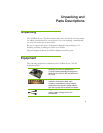
nForce 750i SLI Motherboard
Installing the Motherboard
The sequence of installing the motherboard into the chassis depends on the chassis you are using
and if you are replacing an existing motherboard or working with an empty chassis. Determine if it
would be easier to make all the connections prior to this step or to secure the motherboard and then
make all the connections. It is normally easier to secure the motherboard rst.
Use the following procedure to install the I/O shield and secure the motherboard into the chassis.
Note: Be sure that the CPU fan assembly has enough clearance for the chassis covers to lock into place and for
the expansion cards. Also make sure the CPU Fan assembly is aligned with the vents on the covers.
Installing the I/O Shield
The motherboard kit comes with an I/O shield that is used to block radio frequency transmissions,
protects internal components from dust and foreign objects, and promotes correct airow within the
chassis.
Before installing the motherboard, install the I/O shield from the inside of the chassis. Press the I/O
shield into place and make sure it ts securely. If the I/O shield does not t into the chassis, you
would need to obtain the proper size from the chassis supplier.
Securing the Motherboard into the Chassis
Most computer chassis have a base with mounting studs or spacers to allow the mother board to
be secured to the chassis and help to prevent short circuits. If there are studs that do not align with
a mounting hole on the motherboard, it is recommended that you remove that stud to prevent the
possibility of a short circuit. In most cases, it is recommended to secure the motherboard using a
minimum of nine (9) spacers.
1. Carefully place the motherboard onto the studs/spacers located inside the chassis.
2.
Align the mounting holes with the studs/spacers.
3. Align the connectors to the I/O shield.
4. Ensure that the fan assembly is aligned with the chassis vents according to the fan assembly in
-
struction.
5. Secure the motherboard with a minimum of eight-to-ten screws.


















